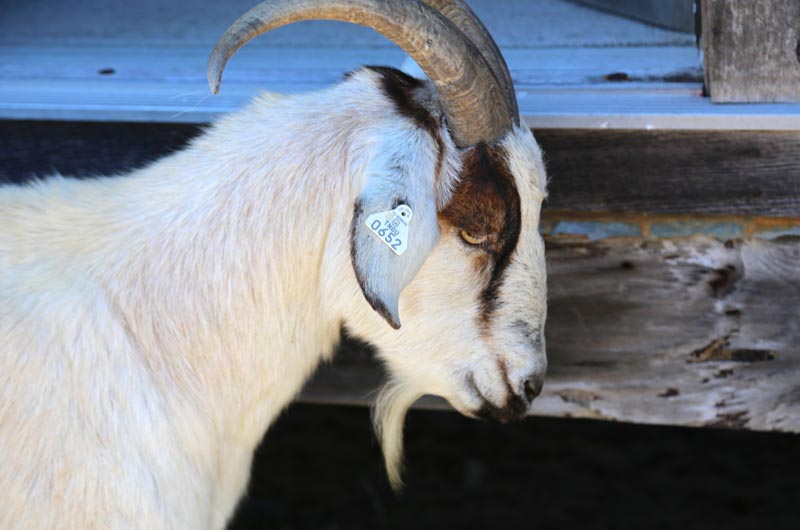On a recent morning, about 120 goats stood at one end of a vast field at Great Pond Farm in Edgartown, shouting and chattering and reveling in the sunshine. The Martha’s Vineyard Land Bank acquired the goats in April, following a two-year pilot program at the Farm Institute, and plans to deploy them as living lawnmowers as early as next week.
The goats will take up residency at Waskosim’s Rock, a 184-acre land bank property in Chilmark, where intensive grazing will be used to transform a large area of woody undergrowth into a diverse native grassland. If all goes well over the next couple of years, the land bank plans to expand the operation to other properties around the Island.
Goats often get a bad rap, said Julie Scott, who along with her husband, Laine Scott, will help run the program. “But these goats in particular are really great goats. They are not escape artists. There is no head butting going on.” She wasn’t sure what accounted for their docile nature other than the fact that they are bred for meat, rather than dairy.
But in this context, their sole purpose will be to graze.
Looking out over the herd, you see a wide assortment of white, brown, black and mottled fur. Most are Kikos, but there also are about 10 Arapawas, a critically endangered breed with mixed colors and hardy characteristics.
During the second year of the pilot program, which included only 10 or 15 goats, the land bank commission realized it had something worth pursuing. It hired goat herder Rebecca Brown, who had helped run the pilot, to continue the program with her own herd this year. But when Ms. Brown took a job off-Island, the land bank decided to buy the entire herd and continue the program itself.
Matthew Dix, the land bank’s conservation lands foreman, had worried that the commission would balk at the idea of herding its own goats. But the Scotts were ideally suited to the task, he said. Mrs. Scott had managed the Farm Institute for seven years and Mr. Scott is a farm hand at Grey Barn Farm in Chilmark. “So it wasn’t much of a leap,” Mr. Dix said.
The commission itself had already seen the light and was enthusiastic, he added. “They also, I think, liked the idea of a more sustainable approach to land management.”
The idea for the grazing program emerged a few years ago when Mr. Dix attended a talk by David Foster, director of the Harvard University Forest, about the history and natural diversity of the Vineyard. The Island’s natural diversity peaked during the era of sheep farming, Mr. Dix said. He explained that woody plants like huckleberry, sumac and scrub oak, which now dominate the landscape, are eradicated by constant grazing, while native grasses like little bluestem can survive the process, giving rise to a more diverse ecosystem. Grazing also allows for more constant maintenance.
“Seasonal mowing is not a natural thing,” Mr. Dix said. “As land manager, I had spent far too many hours on a tractor mowing fields just to watch them grow back into brush the following year.” Animal grazing changes the soil chemistry altogether, supporting native grassland. And while the land bank doesn’t use fire to manage its properties, animal hooves and manure, like fire, can eliminate thatch, further promoting biodiversity.
There are aesthetic benefits to grazing as well. Many of the land bank properties are strewn with glacial boulders and contain stone walls that are difficult to mow around. But goats love to climb on big rocks, Mr. Dix said. “We are hopefully accomplishing a few things at once.”
The approximately 20 acres of meadow at Waskosim’s Rock are full of rocks, but also box turtles, which feed in the meadows and “are extremely susceptible to being mowed,” Mr. Dix said. And eastern box turtles are protected by the state, which requires spotters and other precautions around field machinery. “It’s very cumbersome,” Mr. Dix said.
The land bank bought Ms. Brown’s herd, along with trailers, fencing and other equipment, for $24,260 and plans to build a barn near the Scott’s house at Wapatequa Woods, where the goats will live during the winter. Mr. Dix hopes to maintain the program for between $10,000 and $15,000 per year. By comparison, Ms. Brown had agreed to run the program for three years at a cost of $30,000 per year.
Goats are naturally curious and will taste anything, which makes them excellent grazers, Mr. Dix said. But they do have preferences, and they like to move around as they eat, which may be a challenge. But no food will be added to the system. “I want them to eat stuff that they wouldn’t want to eat unless they were hungry,” Mr. Dix said.
Many of the goats are still small but Mr. Dix hopes eventually to have about 100 full-sized goats taking part in the program, all grazing together in close quarters.
The main challenge with mob grazing, as it’s called, will be adjusting the size and location of the paddocks, based on the amount and distribution of vegetation throughout the season. “It’s a constant evaluation of what the goats are doing,” Mr. Dix said.
It will probably take multiple grazings to affect the landscape, he said, but the hope is that only occasional maintenance will be needed in the future: “It’s probably optimistic at this point, but that’s my goal to work towards.”









Comments (1)
Comments
Comment policy »